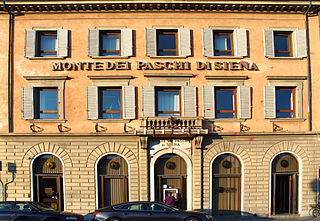Overview
The regulatory definition of an IPS under EU law is set out in article 113(7) of the EU Capital Requirements Regulation, first enacted in 2013. [2] : 14 That text stipulates in particular that an IPS is a "contractual or statutory liability arrangement which protects those institutions [which form it] and in particular ensures their liquidity and solvency to avoid bankruptcy where necessary". It details a number of criteria for IPS designation, including that the IPS "shall be based on a broad membership of credit institutions of a predominantly homogeneous business profile", [3] even though it does not specifically define these concepts. [4] : 7
National authorities are in charge of IPS designations. In the banking union, such designation is operated under guidelines published by the European Central Bank, [5] and ECB Banking Supervision is directly involved in the supervision of IPSs to the extent that the latter include any significant institutions as defined in the European Banking Supervision framework.
IPSs interact with deposit guarantee schemes. Article 4(2) of the Deposit Guarantee Directive 2014 states: "An IPS may be officially recognised as a DGS". Article 13(1) of the same text specifies that "Member States may decide that members of an IPS pay lower contributions to the DGS." Recital 12 further clarifies that where an IPS "is separate from a DGS, its additional safeguard role should be taken into account when determining the contributions of its members to the DGS." Having the two roles embedded in a single entity, however, may weaken the deposit insurance function. [6] : 18

A financial institution, sometimes called a banking institution, is a business entity that provides service as an intermediary for different types of financial monetary transactions. Broadly speaking, there are three major types of financial institution:
- Depository institution – deposit-taking institution that accepts and manages deposits and makes loans, including bank, building society, credit union, trust company, and mortgage broker;
- Contractual institution – insurance company and pension fund
- Investment institution – investment bank, underwriter, and other different types of financial entities managing investments.

A savings bank is a financial institution whose primary purpose is accepting savings deposits and paying interest on those deposits.

Banking regulation and supervision refers to a form of financial regulation which subjects banks to certain requirements, restrictions and guidelines, enforced by a financial regulatory authority generally referred to as banking supervisor, with semantic variations across jurisdictions. By and large, banking regulation and supervision aims at ensuring that banks are safe and sound and at fostering market transparency between banks and the individuals and corporations with whom they conduct business.
Deposit insurance or deposit protection is a measure implemented in many countries to protect bank depositors, in full or in part, from losses caused by a bank's inability to pay its debts when due. Deposit insurance systems are one component of a financial system safety net that promotes financial stability.

Raiffeisen Zentralbank Österreich A.G. (RZB) was a significant bank in Austria and the central institution of the Raiffeisen Banking Group (RBG) until its merger into its subsidiary Raiffeisen Bank International (RBI) in 2017.
The Association of German Public Banks is a leading association within the German banking sector, bringing together most of the German public banking sector except the local-level savings banks. Its membership includes 63 banks, including the Landesbanks that are also members of the Deutscher Sparkassen- und Giroverband (DSGV) and form part of the Sparkassen-Finanzgruppe, and promotional and development banks owned by the Federal Republic of Germany or the individual German federal states.

The Raiffeisen Banking Group is a group of cooperative banks in Austria. The Austrian Raiffeisen banks are not consolidated under a single parent entity but are financially linked through a common institutional protection scheme and deposit guarantee scheme. The group's international operations, by contrast, are consolidated under Raiffeisen Bank International (RBI).
The banking system in Austria plays a pivotal role in the country's economy, ensuring financial stability and providing essential services to both individuals and businesses. The Austrian banking system is characterized by a three-tier structure, consisting of joint-stock banks, savings banks (Sparkassen), and cooperative banks.

The German Cooperative Financial Group is a major cooperative banking network in Germany that includes local banks named Volksbanken and Raiffeisenbanken, the latter in tribute to 19th-century cooperative movement pioneer Friedrich Wilhelm Raiffeisen. The Cooperative Group represents one of the three "pillars" of Germany's banking sector, the other two being, respectively, the Sparkassen-Finanzgruppe of public banks, and the commercial banking sector represented by the Association of German Banks.

Erste Group Bank AG is an Austrian financial service provider in Central and Eastern Europe serving 15.7 million clients in over 2,700 branches in seven countries.
The European System of Financial Supervision (ESFS) is the framework for financial supervision in the European Union that has been in operation since 2011. The system consists of the European Supervisory Authorities (ESAs), the European Systemic Risk Board, the Joint Committee of the European Supervisory Authorities, and the national supervisory authorities of EU member states. It was proposed by the European Commission in 2009 in response to the financial crisis of 2007–08.
The European Systemic Risk Board (ESRB) is a group established on 16 December 2010 in response to the ongoing financial crisis. It is tasked with the macro-prudential oversight of the financial system within the European Union in order to contribute to the prevention or mitigation of systemic risks to financial stability in the EU. It shall contribute to the smooth functioning of the internal market and thereby ensure a sustainable contribution of the financial sector to economic growth.

The European Banking Authority (EBA) is a regulatory agency of the European Union headquartered in La Défense, Île-de-France. Its activities include conducting stress tests on European banks to increase transparency in the European financial system and identifying weaknesses in banks' capital structures.

European Banking Supervision, also known as the Single Supervisory Mechanism (SSM), is the policy framework for the prudential supervision of banks in the euro area. It is centered on the European Central Bank (ECB), whose supervisory arm is referred to as ECB Banking Supervision. EU member states outside of the euro area can also participate on a voluntary basis, as was the case of Bulgaria as of late 2023. European Banking Supervision was established by Regulation 1024/2013 of the Council, also known as the SSM Regulation, which also created its central decision-making body, the ECB Supervisory Board.

The Single Resolution Mechanism (SRM) is one of the pillars of the European Union's banking union. The Single Resolution Mechanism entered into force on 19 August 2014 and is directly responsible for the resolution of the entities and groups directly supervised by the European Central Bank as well as other cross-border groups. The centralised decision making is built around the Single Resolution Board (SRB) consisting of a chair, a Vice Chair, four permanent members, and the relevant national resolution authorities.
The banking union refers to the transfer of responsibility for banking policy from the national to the European Union (EU) level in several EU member states, initiated in 2012 as a response to the Eurozone crisis. The motivation for banking union was the fragility of numerous banks in the Eurozone, and the identification of a vicious circle between credit conditions for these banks and the sovereign credit of their respective home countries. In several countries, private debts arising from a property bubble were transferred to the respective sovereign as a result of banking system bailouts and government responses to slowing economies post-bubble. Conversely, weakness in sovereign credit resulted in deterioration of the balance sheet position of the banking sector, not least because of high domestic sovereign exposures of the banks.

The Single Resolution Board (SRB) is an EU agency that was established in Brussels in 2015 as part of the broader set of reforms known as the banking union. It acts as the resolution authority for a subset of banks in the euro area and as the institutional hub of the Single Resolution Mechanism (SRM). Resolution is the restructuring of a bank by a resolution authority through the use of resolution tools in order to safeguard public interests, including the continuity of the bank's critical functions and financial stability, at minimal costs to taxpayers.
The Sparkassen-Finanzgruppe is a network of public banks that together form the largest financial services group in Germany and in all of Europe. Its name refers to local government-controlled savings banks that are known in German as Sparkasse, plural Sparkassen. Its activity is overwhelmingly located in Germany.

The Sparkassengruppe Österreich brings together all savings banks in Austria. It serves around 4 million customers in 797 branches with more than 15,500 employees, with a customer share in Austria around 31.2% as of December 2022. In 2020 it had total assets of €277 billion, ahead of Raiffeisen Bank International, UniCredit Bank Austria, and BAWAG Group, making it the largest Austrian banking group. The group has a complex decentralized structure but relies critically on Erste Group Bank AG, which owns the main local savings bank in Vienna, operates central functions, owns and manages subsidiaries outside of Austria, and consolidates group accounts.










